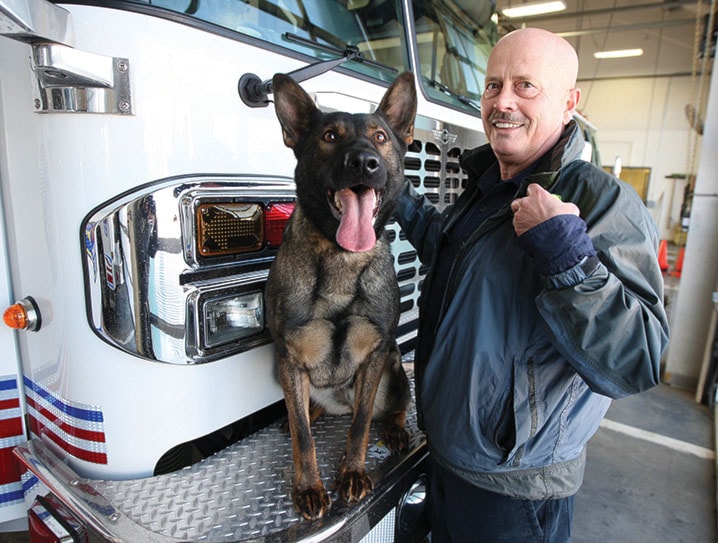Even though she’s a German shepherd, Eza is a rare breed.
That’s because she can go through a scene after a fire to help determine whether there are any signs of substances — like gasoline — that could have helped spread flames. That could mean the fire was arson.
Eza is half of a specially trained canine accelerant team — the other half is Jeff Lunder, her owner.
There are only a few other teams in Western Canada — one each in Edmonton and Kelowna, and the Calgary fire department has two dogs used only within city limits.
In 2011, Lunder, 58, retired as a fire-medic after 36 years with City of Red Deer Emergency Services. He has also trained dogs for 40 years through the Red Deer Kennel Club and judges obedience trials in Canada and the United States for almost 30 years.
He found the idea of training an accelerant dog intriguing so he decided to try it.
Lunder has always had German shepherds — his favourite — but when his shepherds were checked out to possibly train, they were called “couch potatoes.” He needed a dog with a lot of drive.
He ended up buying the purebred Eza from the RCMP training kennels in Innisfail when she was nine months old. He then hired a retired police officer, who had been involved with the RCMP dog training program, to help him train Eza.
Eza (pronounced eeza) is now three years old and after a lot of hard work the pair are a certified accelerant canine team. The dog’s training continues every day.
She’s a working dog, not a pet, said Lunder.
“I thought it would be a real easy thing to do, and it was one of the hardest things I ever did in my life,” he said.
In her first year, Eza was exposed to many different conditions, such as slippery floors, darkness, heights, going under and over things, and jumping on things. Then she was introduced to the smell of gasoline that had sat out for months so it wasn’t as potent. It was placed on a rag inside a toy, so she couldn’t get at it.
She learned to bring the toy back, then to do a passive alert (sitting at the source of the odour) and then to stay until she was told different.
Over time Eza was trained to recognize 13 different accelerants, such as gasoline, diesel fuel, acetone, kerosene, lighter fluid and barbecue lighter fluid.
In September, Lunder took Eza to the U.S. for a week, to be certified by the Canine Accelerant Detection Organization. The canine team must attain 100 per cent to pass. They passed, and now must be re-certified every year.
Eza and Lunder can now work for any organization, and they’ve been extremely busy. Lunder has a contract with Global Forensics, which does a lot of fire investigating for insurance companies.
At the first fire scene Eza attended, she found accelerants, said Lunder. He can’t talk about the case because it is under investigation and could end up in court.
The dog is only a tool, said Lunder, and if she does hit on anything, it’s marked, evidence is collected and then sent to a lab for testing. Lunder keeps meticulous log records of everything he does with the dog during an investigation as well as when they are practising and training.
At least once a week, whether a fire is suspicious or not, the pair will go through a fire site as an exercise to keep Eza on her toes (paws). He always checks a site first though to make sure it’s safe to send the dog through it. He admits that he worries all the time about what she may be inhaling.
They’ve been all over Central Alberta.
“It’s a blast. It really is. It’s exciting and doing what I did for my whole career, but at a different level.”
Eza enjoys it. “When we get to a scene she just goes into another gear. It’s incredible. She just loves to go.”
The use of working dogs continues to expand.
Lunder said there is a police canine team in the U.S. where the dog can detect electronics, by way of the precious metals used in them. The dog can find items like hidden cell phones or computers.
This is getting a lot of interest by police departments in the States, Lunder said.
barr@www.reddeeradvocate.com
